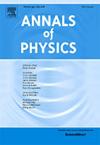对称多量子位系统的纠缠力:几何方法
IF 3
3区 物理与天体物理
Q2 PHYSICS, MULTIDISCIPLINARY
引用次数: 0
摘要
具有高纠缠功率的单一门由于其纠缠能力而与许多量子增强技术相关。对于对称多量子位系统,如自旋态或玻色子系统,粒子交换对称性限制了这些门,也限制了非纠缠态的集合。在这项工作中,我们通过将其重新表述为具有SU(2)不变量的分量的向量之间的内积来分析这些系统中幺正门的纠缠功率。对于少量量子比特,这种方法允许我们分析地研究纠缠功率,包括检测使其最大化的幺正门。我们观察到,极酉门表现出高度旋转对称的纠缠分布,与某些态的胡西米函数的凸组合相关联。此外,我们还探讨了纠缠功率与某些量子态子空间中允许的施密特数之间的关系。因此,本文提出的几何方法为研究量子信息理论中与其他概念相关的纠缠力提供了新的途径。本文章由计算机程序翻译,如有差异,请以英文原文为准。
Entangling power for symmetric multiqubit systems: A geometrical approach
Unitary gates with high entangling power are relevant for several quantum-enhanced technologies due to their entangling capabilities. For symmetric multiqubit systems, such as spin states or bosonic systems, the particle exchange symmetry restricts these gates and also the set of not-entangled states. In this work, we analyze the entangling power of unitary gates in these systems by reformulating it as an inner product between vectors with components given by SU invariants. For small number of qubits, this approach allows us to study analytically the entangling power including the detection of the unitary gate that maximizes it. We observe that extremal unitary gates exhibit entanglement distributions with high rotational symmetry, same that are linked to a convex combination of Husimi functions of certain states. Furthermore, we explore the connection between entangling power and the Schmidt numbers admissible in some quantum state subspaces. Thus, the geometrical approach presented here suggests new paths for studying entangling power linked to other concepts in quantum information theory.
求助全文
通过发布文献求助,成功后即可免费获取论文全文。
去求助
来源期刊

Annals of Physics
物理-物理:综合
CiteScore
5.30
自引率
3.30%
发文量
211
审稿时长
47 days
期刊介绍:
Annals of Physics presents original work in all areas of basic theoretic physics research. Ideas are developed and fully explored, and thorough treatment is given to first principles and ultimate applications. Annals of Physics emphasizes clarity and intelligibility in the articles it publishes, thus making them as accessible as possible. Readers familiar with recent developments in the field are provided with sufficient detail and background to follow the arguments and understand their significance.
The Editors of the journal cover all fields of theoretical physics. Articles published in the journal are typically longer than 20 pages.
 求助内容:
求助内容: 应助结果提醒方式:
应助结果提醒方式:


